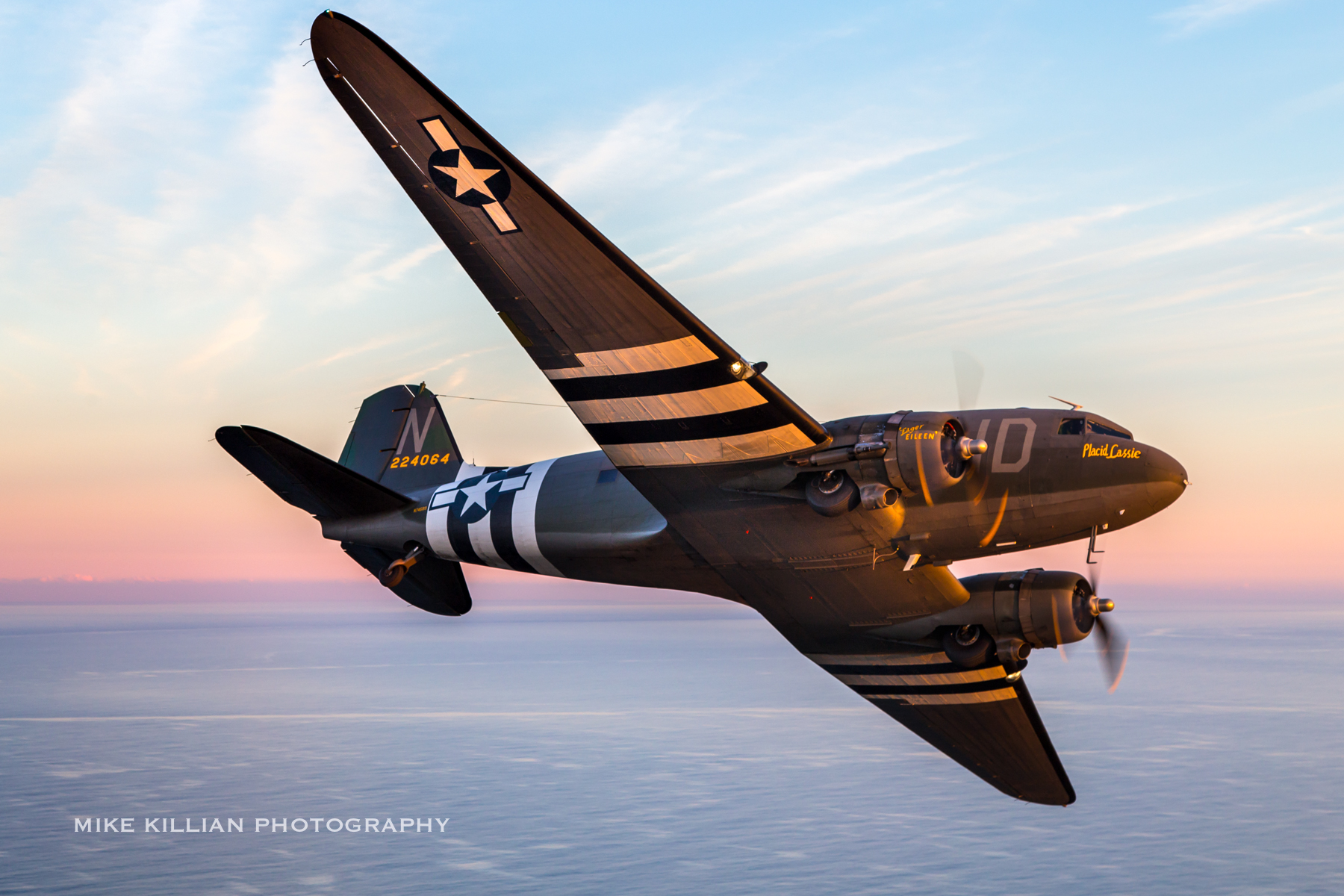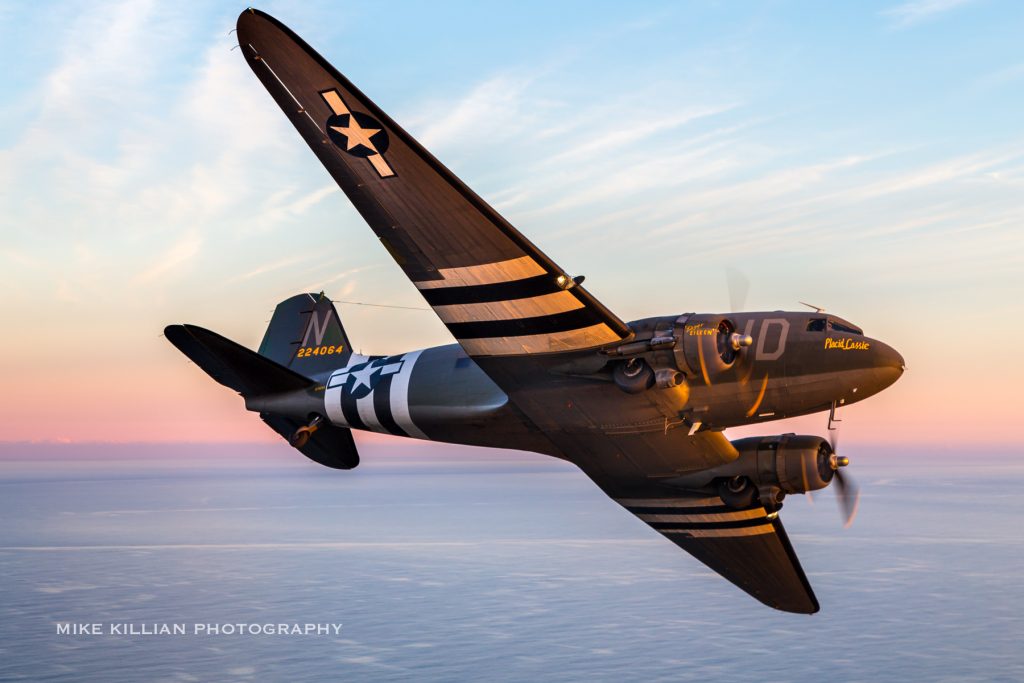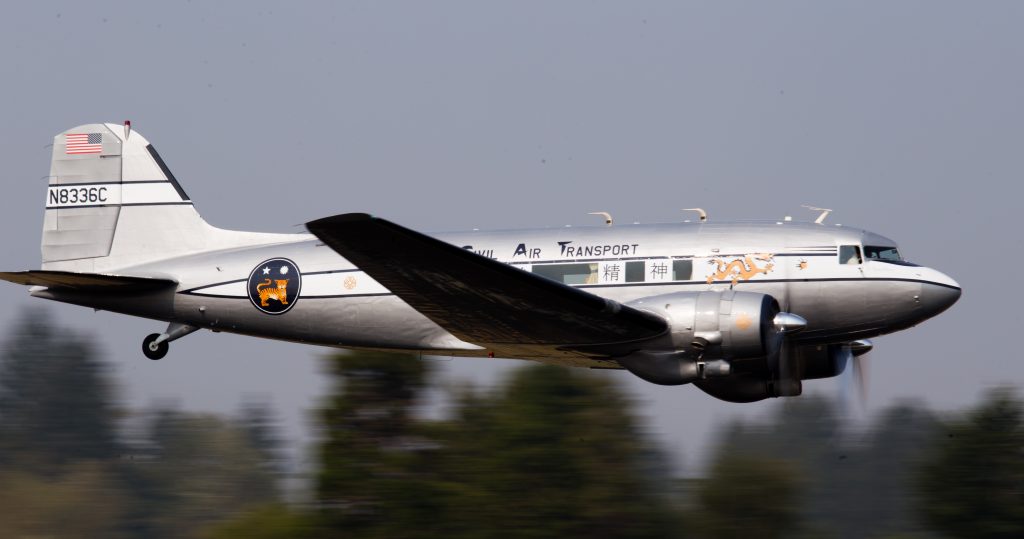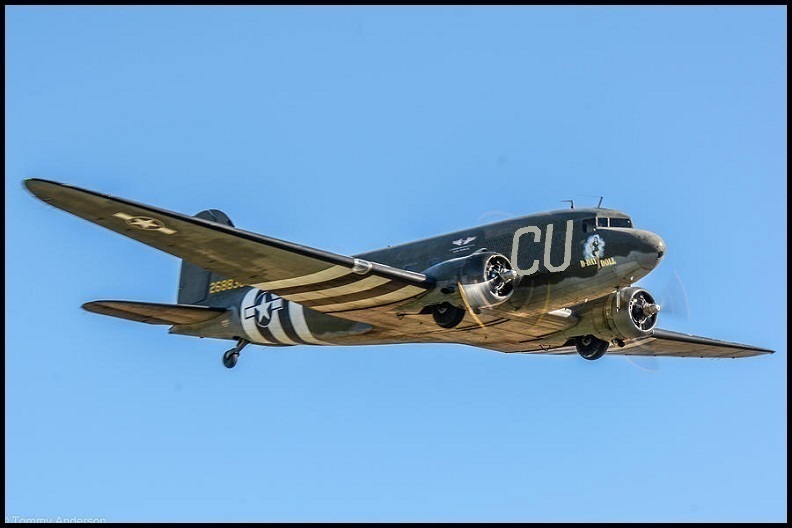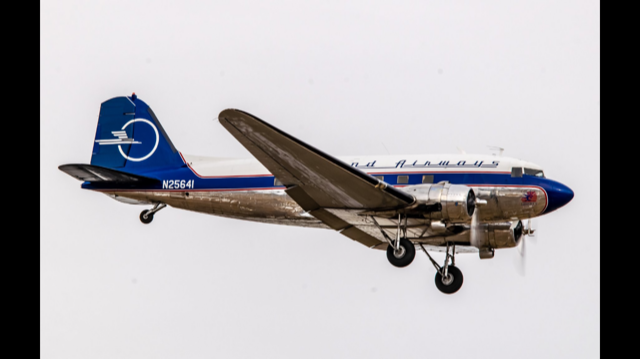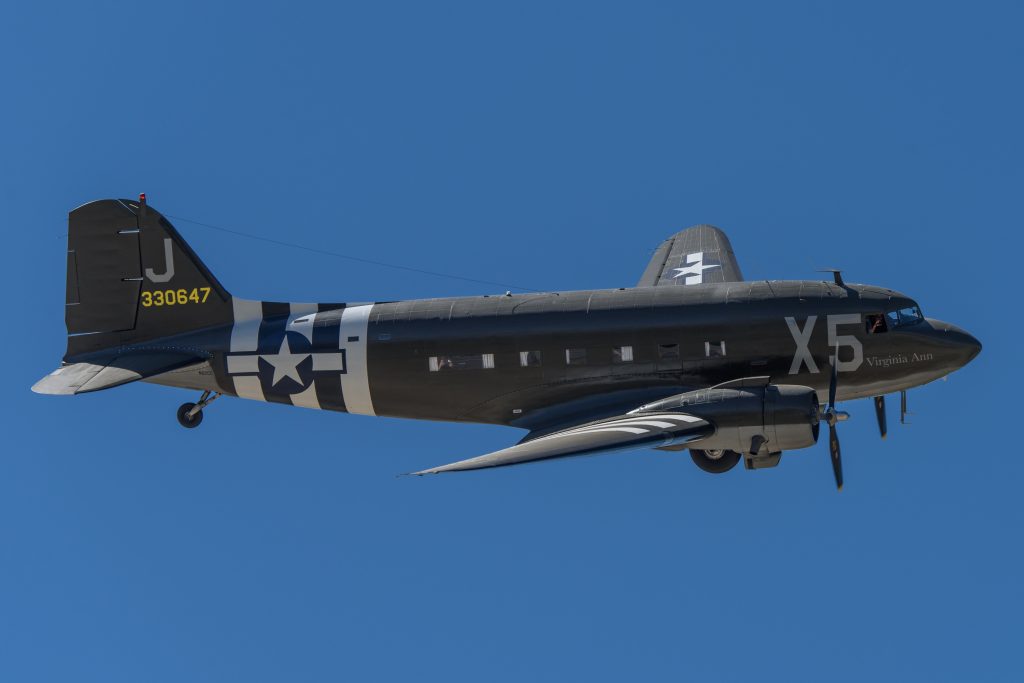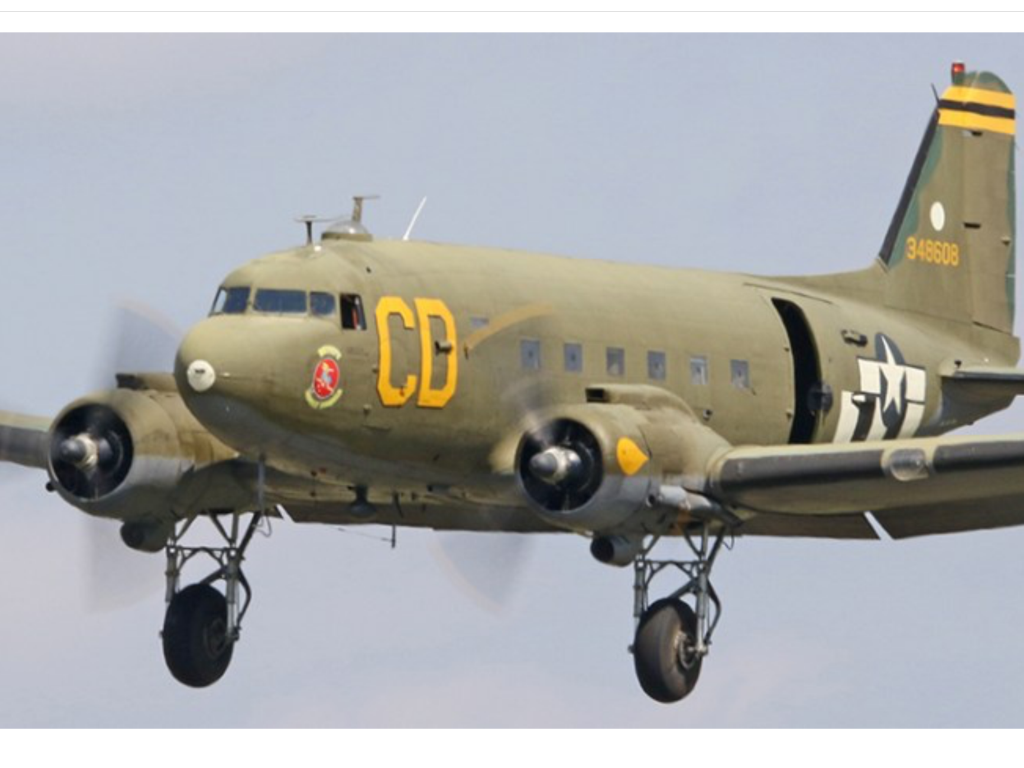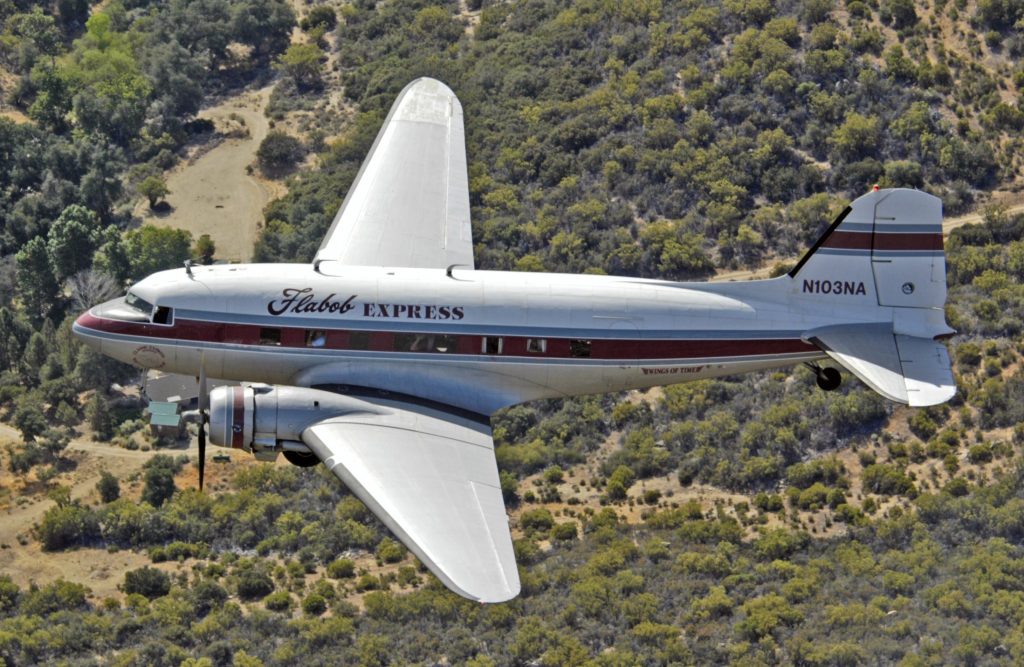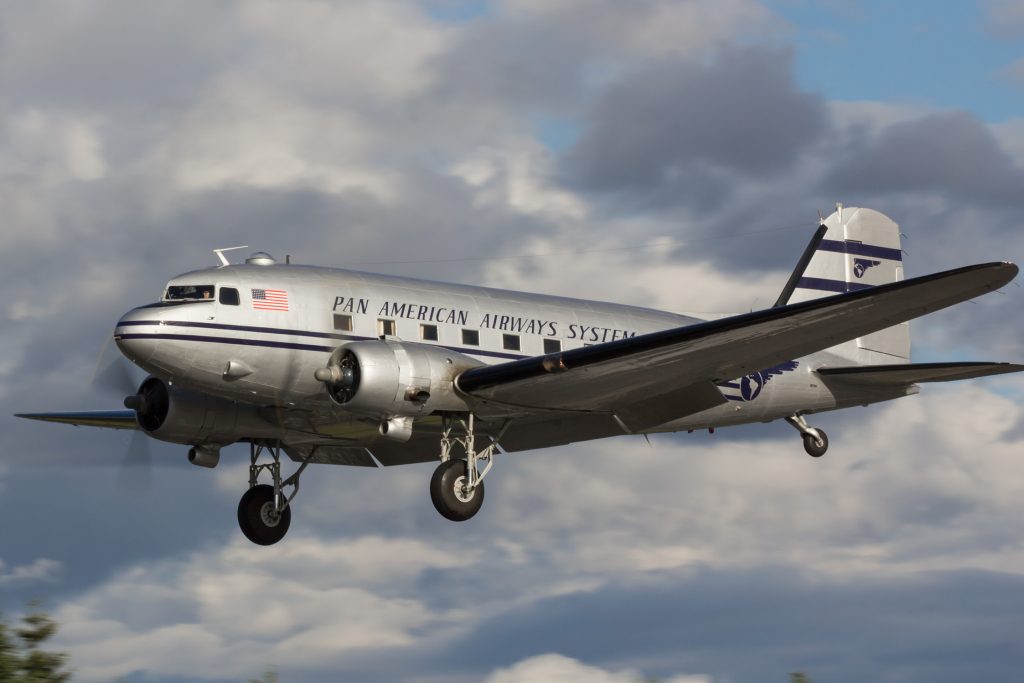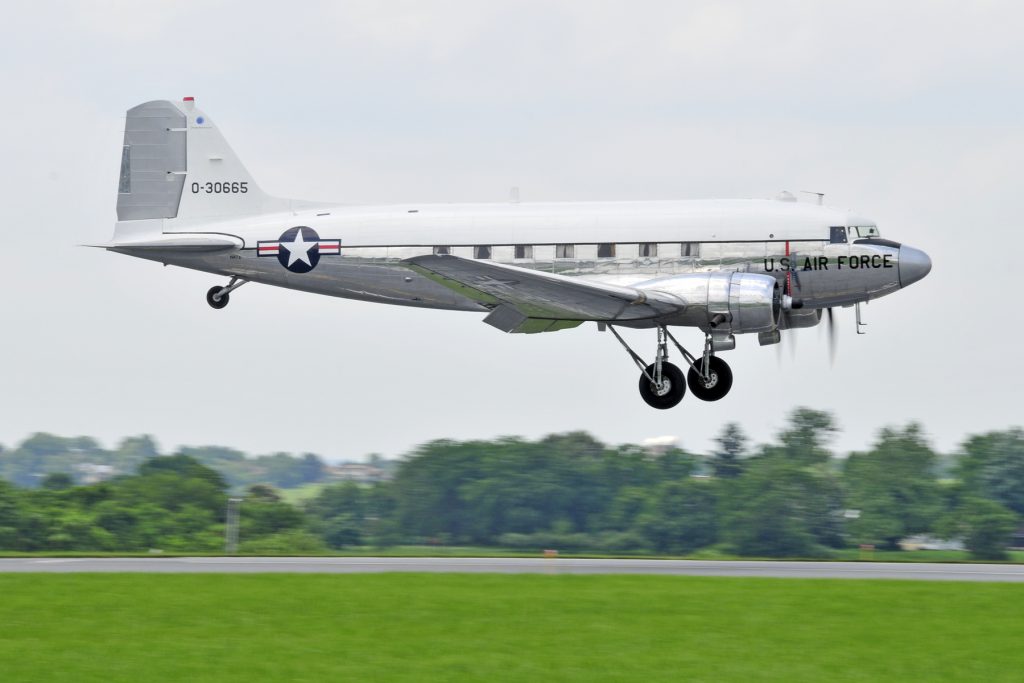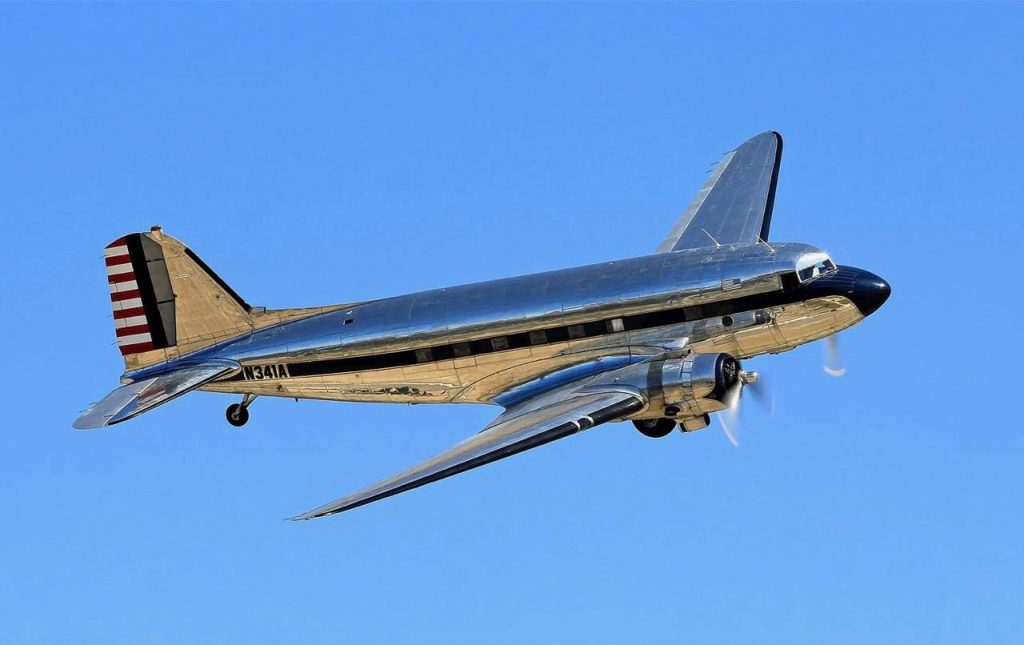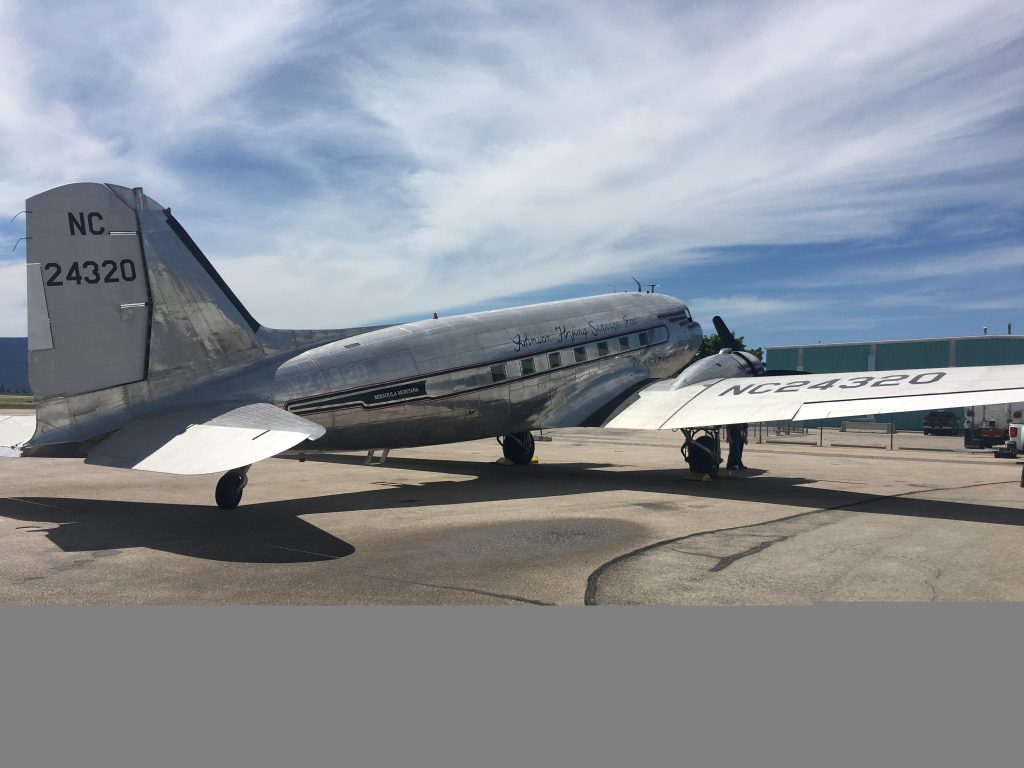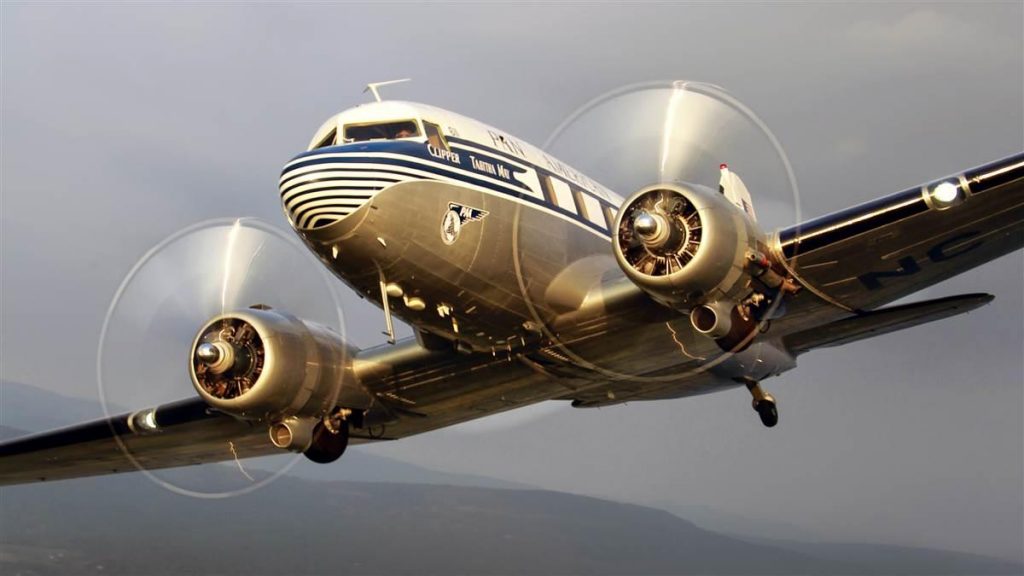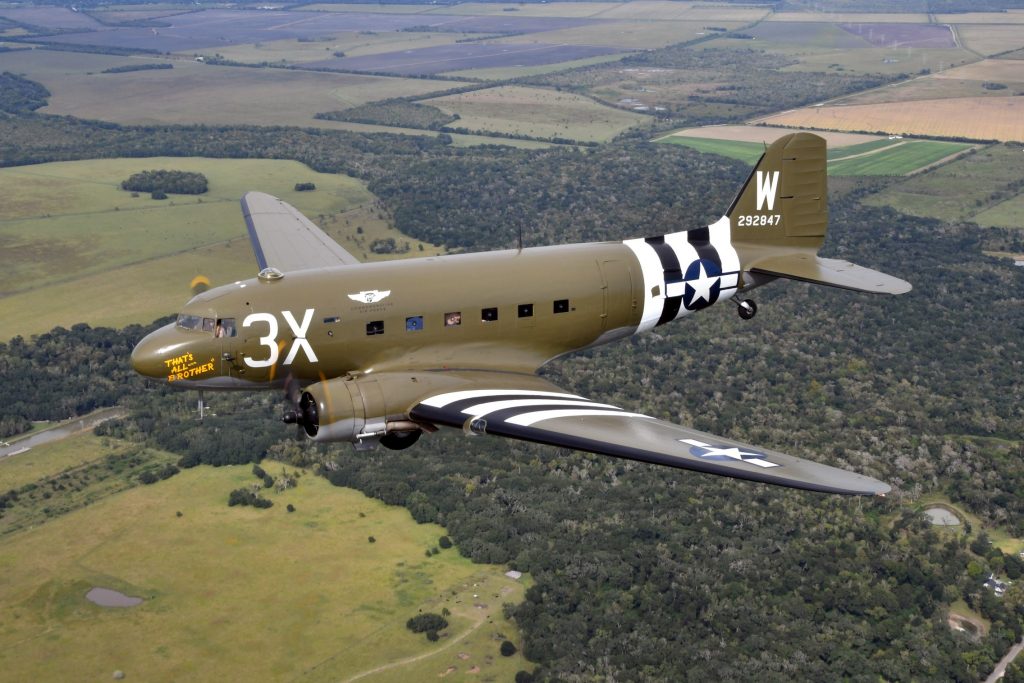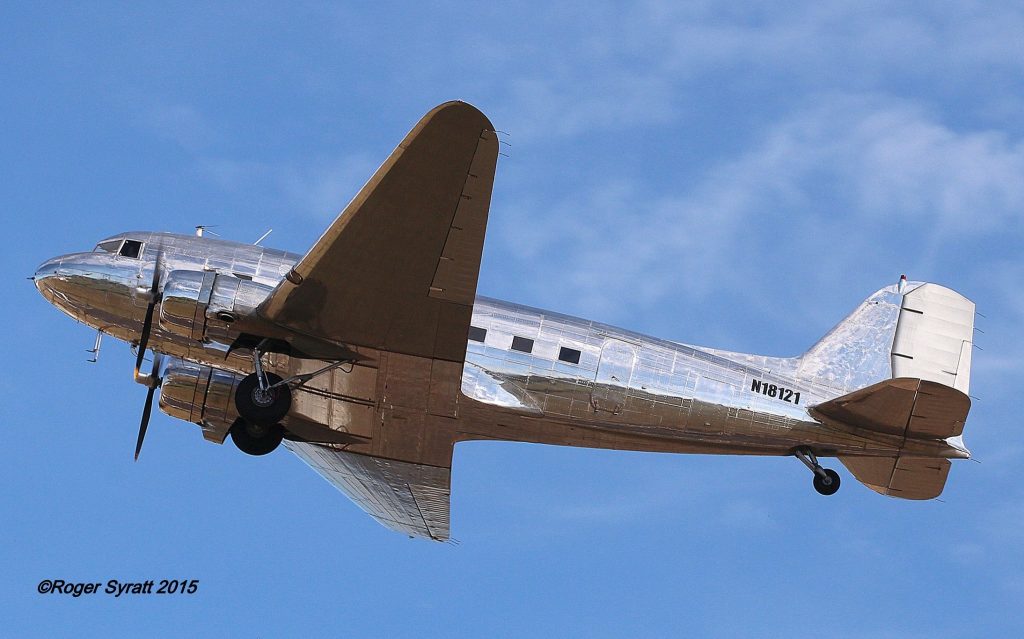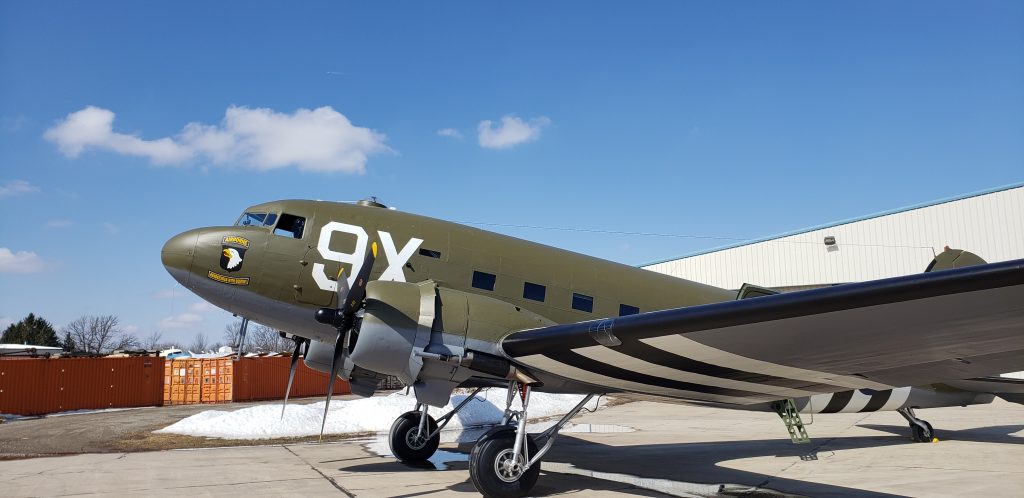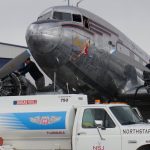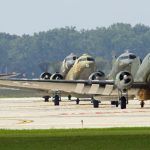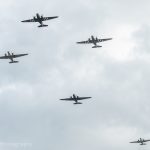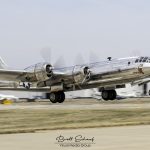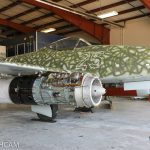By Moreno Aguiari and Richard Mallory Allnutt
After almost 18 months of planning, fundraising and training, the D-Day Squadron, the American contingent of Douglas C-47 and DC-3 transports participating in Daks over Normandy, is about to embark upon their journey to Europe to celebrate the 75th anniversary of D-Day. On May 19th, the D-Day Squadron will depart Oxford-Waterbury airport in Connecticut and head East to cross the Atlantic along the original Blue Spruce route. There will be a full week of activities to kick off this event, including a special Squadron flyover of the Statue of Liberty. All the details can be found HERE.
The list of airplanes taking part is changing regularly, as is understandable when juggling such a monumental challenge. Some teams tried until last minute to get their aircraft ready to take part, but the complexity of the mission, the logistical challenges and the enormous costs involved inevitably took a toll with some having to cancel their participation. The following is the ONLY OFFICIAL list approved by the D-Day Squadron at this time marking which aircraft will participate…. as they like to call it…The Mighty Fifteen!
1- C-47A-40-DL Skytrain 42-24064 – Placid Lassie – N74589 – Lead Aircraft
Placid Lassie was built at Douglas Aircraft’s plant in Long Beach, California and delivered to the U.S. Army Air Forces in early 1943. They assigned her to the 74th Squadron, 434th Troop Carrier Group of IX Troop Carrier Command in England in preparation for D-Day.
On that fateful day, June 6, 1944, Placid Lassie, along with 832 other C-47s towed WACO CG-4A and AirCo Hadrian cargo gliders and dropped more than 24,000 paratroopers over Normandy. Thereafter, Placid Lassie participated in additional WWII combat engagements including: Operation MARKET GARDEN in the Netherlands (September 17- 25 1944), Operation REPULSE – the relief of Bastogne during the Battle of the Bulge (December 23-25, 1944), Operation VARSITY (March 23, 1945).
Like many of her brethren following WWII, the aircraft went through a number of civilian owners, plying her trade as a cargo plane. This historic C-47 is now owned and operated by the Tunison Foundation ,a nonprofit organization. Placid Lassie is still equipped to drop paratroopers and she carries her original wartime name. Lassie and her crew appear at aviation events across the United States each year, including EAA AirVenture Oshkosh Charitable gifts to the foundation keep this aircraft flying as a living-history tribute to the greatest generation. For more information visit www.tunisonfoundation.org,
2 – C-53-DO Skytrooper 42-47371 – Spirit of Benovia – N8336C
Spirit of Benovia, was built at Douglas Aircraft’s plant in Santa Monica, California and accepted by the U.S. Army Air Forces on June 29th, 1942. The C-53 was primarily designed to drop paratroopers and tow gliders, and differs from the C-47 in having a lighter strength floor and no double cargo door. She flew out to Karachi, India (now Pakistan) in August, 1942, initially for service with the Royal Air Force as serial FJ712, but transferred to the 1st Troop Carrier Squadron, 10th Air Force, USAAF in late December, 1942, serving the rest of the war in the CBI Theatre. She went into civilian ownership in India, then China right after WWII, being owned for a while by General Claire Chennault, reportedly flying Chiang Kai-shek in the Civil Air Transport company out of Taipei, Formosa (now Taiwan). During the mid-50s, the aircraft received a luxurious VIP interior and an AiResearch Maximizer speed kit. She passed through several other owners over the years, including the Kalamazoo Aviation History Museum during the 1980s. The aircraft is currently owned and lovingly cared for by Joe Anderson and Mary Dewane, owners of Benovia Winery in California. For more information visit www.benoviawinery.com
3 – C-53-DO Skytrooper 42-68830 – D-Day Doll – N45366
D-Day Doll was built at Douglas Aircraft’s plant in Santa Monica, California in July 1943 and delivered to the U.S. Army Air Corps soon afterwards. She was assigned to the 434th Troop Carrier Group, 72nd Troop Carrier Squadron at RAF Aldermaston, England, and is a veteran of Operations Overlord (D-Day, Normandy France), Market Garden (Holland), Repulse (Bastogne, Belgium) and Varsity (the crossing of the Rhine, Germany). The aircraft had many civilian owners as an airliner and cargo transport following WWII. She has been owned by the Commemorative Air Force since 2001, and flies regularly at air shows in the western US with the CAF’s Inland Empire Wing from their home in Riverside, California. For more information visit www.inlandempirecaf.com.
4 – C-47-DL Skytrain 42-32833 – Legend Airways ‘Liberty’ – N25641
Legend Airways ‘Liberty’ was built at Douglas Aircraft’s factory in Long Beach, California, rolling off the assembly line on February 11th, 1943. Initially, she was stationed in Oran, Algeria during the North Africa Campaign, arriving on August 17th, 1943. By June 6th, 1944 Liberty was based at RAF Barkston Heath, England, with the 61st Troop Carrier Group. As Chalk #21, with Capt. Lyon in command, she flew on Serial 24 of Operation Overlord and dropped elements of the 82nd Airborne’s 2nd BTN, 507thPIR over the drop zone in Normandy, France. Work orders for the “repair of bullet holes” are still amongst her records. She was then transferred to the 8th Air Force for the remainder of the war and arrived back in the United States on August 17th, 1945, two years to the day from the time she first touched down in the Algerian desert.
At the conclusion of the War, Liberty was decommissioned, sold into private hands and upgraded from military freighter to a corporate executive aircraft. She led a very pampered life, flying out of Shreveport, Louisiana for nearly 25 years. After another 25 years and five owners later, Erik L. Fleming, President of the Fleming Corporation, purchased the historic aircraft.
In early 1993, after amassing 18,500 hours flight time, 42-32833 began a total restoration at Basler Turbo Conversions in Oshkosh, Wisconsin. Completed in 1995, at a cost of nearly $2 million, she had undergone a major make over – right down to her original polished aluminum – in that classic ‘40s/’50s style. The interior was gutted in the process, with the traditional spartan seating replaced by 14 large and very comfortable club-style chairs richly upholstered with fabric imported from Italy. The carpet was custom made in Spain. The cotton headliner was woven in France. And of course, the aircraft’s avionics and cockpit were upgraded to the state-of-the-art, as were the heating and air conditioning systems. The latest technology in soundproofing and insulation make her the quietest, most comfortable ‘DC-3’ ever to ride in. Rich, hand-made hardwood accents give her interior a very appealing, club-like ambience.
JB Air Services LLC of Brighton Colorado is the aircraft’s current custodian. Her life is now very relaxed, flying being limited to aircrew training, pleasure excursions, and the occasional air show. For more information visit www.legendairwaysfoundation.com
5 – C-47A-60-DL 43-30647 – Virginia Ann – N62CC
The Virginia Ann was built at Douglas Aircraft’s factory in Long Beach, California, and was delivered to the U.S. Army Air Force on September 21st, 1943. She was initially assigned to the 12th Air Force in January, 1944, but transferred to 59th Squadron of the 61st Troop Carrier Group in the 9th Air Force shortly thereafter. On D-Day, based at RAF Barkston Heath in England, Colonel Willis Mitchell chose Virginia Ann to lead the 61st TCG with her four squadrons, the 14th, 15th, 53rd and 59th, 72 C-47s, on Serial 24. They were carrying elements of the 2nd Battalion, 507th Parachute Infantry Regiment of the 82nd Airborne. Colonel Mitchell received the Purple Heart for injuries he sustained that early morning. Virginia Ann was involved in resupply and injured evacuation operations in the days following the June 6th invasion. The aircraft went on to participate in Operations Market Garden and Varsity. Following WWII, Virginia Ann went on to a life in the civilian sector as a transport. Mission Boston D-Day LLC, of Newport Beach, California have owned the historic aircraft since 2016, and she is presently painted in the same livery she wore back in June, 1944.
6 – C-47B-5-DK 43-48608 – Betsy’s Biscuit Bomber – N47SJ
This C-47 rolled off Douglas Aircraft’s production line in Oklahoma City, Oklahoma during the summer of 1944. The U.S. Army Air Force accepted her on September 4th, 1944. She served with the 9th Air Force in Europe, but was obviously too late to see service during D-Day. She remained in U.S. military until after the war. Her nickname, Betsy’s Biscuit Bomber, derives from her time taking part in the Berlin Air Lift during 1948. She also served with the Belgian, French and Israeli Air Forces, retiring from the latter in the early 90s. The aircraft was brought back to the USA in 1999, where she has since received a restoration back to airworthy condition as probably the lowest total airframe time C-47 known to exist (under 10,000 hours). Never having received a civilian conversion, she is one of the most authentic original C-47s currently flying. She is currently owned by the Gooney Bird Group in Templeton, California. For more information visit www.betsysbiscuitbomber.com
7 – C-47A-30-DL 42-23669/FD879 – Flabob Express – N103NA
This aircraft rolled of Douglas Aircraft’s production line in Long Beach, California during spring, 1943, being delivered to the U.S. military on May 12th. She was transferred a week later to Britain’s Royal Air Force as a Douglas Dakota, where she served as FD879 with No.24 Squadron, initially based at RAF Hendon. The aircraft was transferred to British forces in India on July 1st, 1943. She became the personal transport, nicknamed Orion, for General Claude Auchinleck, then serving as Commander in Chief of the Indian Army. Following the war, and Indian independence, and later partition in 1947, FD879 became part of the newly-formed Pakistan Air Force. In the early 1950s, FD879 was sold onto the civilian market, one of several similar airframes acquired by Lee Mansdorf. Shipped to the USA in April, 1952, the aircraft received the U.S. civil registration N2701A and a conversion into an executive transport soon after arrival. In 1955, the aircraft was exported to Canada where she passed through several owners before again returning to the USA in 1993 to become the Flabob Express, the signature aircraft of historic Flabob Airport in Riverside, California. It has served in a variety roles, and lately taken part in the educational programs for young people run by the Tom Wathen Center, owners of Flabob Airport. It is owned by Flabob Aviation Associates, a non-profit organization of experienced pilots and mechanics dedicated to keeping her flying. For more information visit www.flabobairport.org/
8 – C-47B-1-DL 43-16340 – Pan Am – N877MG
The Historic Flight Foundation’s DC-3 began life in the Douglas Aircraft Co. Long Beach plant as one of 300 C-47s built specifically for the China-Burma-India theater of operations. Unique features include long-range fuel tanks and supercharged engines for performance at altitude. Delivered to China National Aviation Corporation (CNAC) in Calcutta, it supplied U.S. armed forces and Nationalist Chinese from 1944 to 1945. Pan American Airways partnered with the Nationalist Chinese government to operate CNAC. Many CNAC pilots had flown with the Flying Tigers, by then disbanded. These pilots sought cloudy weather or flew at night to avoid Japanese fighter planes. From April 1942, when the Burma Road was lost, until the end of the war in August 1945, CNAC crews made more than 38,000 trips over the Himalayan mountains, or ’the Hump’ as it was referred to colloquially. They transported approximately 114,500 tons of people and supplies. Post-war, CNAC continued its operations as the leading airline in mainland China. In 1949, Civil Air Transport (CAT) acquired CNAC. Claire Chennault, of Flying Tigers fame, had formed CAT with the support of the U.S. State Department to keep CNAC aircraft out of Communist hands. Even so, the Communist and Nationalist Chinese disputed ownership of 71 former CNAC aircraft through British courts in Hong Kong. During this aircraft’s three-year stay at Hong Kong’s Kai Tak Airport, waiting for the dispute to be resolved, she suffered damage when a booby-trap, apparently the work of a Nationalist agent, exploded and created a hole in the starboard wing. The court case ended favorably for CAT, and as a result, N877MG was soon on a ship bound for the USA. Grand Central Aircraft Company in Glendale, California converted the aircraft into a ‘Super DC-3’. Its new life as a VIP aircraft spanned five decades and included many owners, such as the International Shoe Machine Co. and Johnson & Johnson. The Historic Flight Foundation acquired N877MG in 2006 and based her at Paine Field, their home in Mukilteo, Washington State. Shortly thereafter, they began to restore the historic transport with the intention of recreating a Pan American Airways DC-3 airliner from 1949, while preserving the interior luxury enjoyed by corporate executives of the period. For more information visit www.historicflight.org
9 – C-47A-60-DL 43-30665 – Miss Virginia – N47E
This aircraft rolled of Douglas Aircraft’s production line in Long Beach, California during the late summer of 1943, being delivered to the U.S. military on September 23rd. She remained based in the USA for her entire military service career, which lasted until her retirement in the early 1970s. She performed a variety of missions during those decades, including time with troop transport, special weapons center, research and development units and even the National Guard. The military retired the aircraft to the boneyard at Davis-Monthan AFB near Tucson, Arizona in December, 1974, but she didn’t stay there long before sale onto the civilian market as N48065. The Wycliffe Bible Transport and Jungle Aviation and Radio Service ( JAARS) operated her for many years in the jungles of Colombia. In 1990, Dynamic Aviation of Bridgewater, Virginia purchased the aircraft and modified her for mosquito and gypsy moth spraying. They eventually retired her again in 1999. However, in 2010 they chose to restore the aircraft back into her military guise and named her Miss Virginia. Dynamic Aviation continue to fly Miss Virginia on the air show circuit. For more information visit www.dynamicaviation.com
10 – C-41A 40-0070 Hap-Penstance – N341A
N341A is the one and only Douglas DC-3 variant designated as a C-41A. The U.S. Army Air Forces ordered her in 1938 and delivered her to Bolling AFB on September 14th, 1939 at a cost of $105,611.29. This was one of two aircraft requisitioned by Major General Henry ‘Hap’ Arnold as VIP transports for himself and military command staff, as well as other high ranking officials including the Secretary of War. Interestingly, her sister ship (designated as a C-41) is also still flying today – as N41HQ. These aircraft were based at Bolling Army Airfield in Washington, D.C. as a part of the 1st Staff Squadron. The aircraft was well appointed, and the main cabin was equipped with swivel seating to allow for inflight meetings. The forward cabin was originally configured with four sleeping berths and upper skylights, similar to those found on the original DSTs (Douglas Sleeper Transports). The military disposed of the aircraft soon after the end of WWII, and before too long, she entered civilian life as an executive transport, passing through various owners until her rarity brought attention from flying museums in the late 1980s. She has passed through several museums, including Planes of Fame East and the Lone Star Flight Museum. The airplane is currently owned and operated by Golden Age Air Tours in Sonoma, California. N341A today retains her original distinctive tail insignia and bare metal finish, albeit now highly polished and with the addition of dark blue highlighting along the fuselage window line. This unique aircraft is one of the lowest time DC-3 variants currently flying, with less than 10,000 hrs total time – there are examples still flying today with well over 90,000 hrs on the clock!
11 – C-47A-90-DL 43-15731 – Miss Montana – N24320
This aircraft rolled of Douglas Aircraft’s production line in Long Beach, California during the spring of 1944, being delivered to the U.S. Army Air Forces on May 6th. She served initially as part of Air Transport Command at the Specialized Night and Instrument Training School at Rosencrans Army Airfield in St. Joseph, Missouri. This was followed by a move to Memphis, Tennessee in June, 1945, but her stay there did not last long as she was retired for storage and eventual resale at the massive Walnut Ridge site in Arkansas. While she did not see combat in WWII, she has had a significant, although somewhat sobering civilian career, being one of the aircraft used to pioneer the concept of ‘smoke jumping’. Smoke jumpers are firefighters who parachute into the wilderness to combat forest fires. In fact, N24320 is the airplane that flew smokejumpers to fight the infamous Mann Gulch Fire near Helena, Montana in 1949. Sadly, twelve smokejumpers and one smoke chaser perished in this tragic episode, when they were overrun by the intense conflagration. Unfortunately the aircraft was involved in another tragedy while under the ownership of Johnson Flying Service. On December 22nd, 1954 the aircraft was forced to ditch in the Monongahela River near McKeesport, Pennsylvania due to lack of fuel. While no one was hurt during the initial accident, and the plane floated for long enough for everyone to exit the fuselage onto the wings, nine passengers and the pilot drowned trying to get to shore through the frigid waters. Amazingly, the airframe was salvaged, repaired, and returned to service. The aircraft has passed through several different operators since, and is now owned and displayed by the Museum of Mountain Flying in Missoula, Montana as a tribute to those smokejumpers who perished in the Mann Gulch Fire, and to all smokejumpers who continue to help protect America’s precious forests. Interestingly, Johnson Flying Service, which was a FBO in Missoula, Montana is also significantly represented at the Museum. Indeed, the FBO provided much of the training and first piloting opportunities for many museum members. N24320 was located by Museum founder Dick Komberec, a retired Delta Airlines pilot whose early flying experience included working for Johnson Flying Service. Komberec spotted N24320 near Atlanta, Georgia during one of his flights to that area, and the Museum undertook fundraising efforts to purchase her, which they accomplished in 2002. She has been a centerpiece at the museum ever since.
The museum decided to fly their C-47 to Normandy to honor the participation of over 57,000 Montana citizens who served during World War II in all branches of the military, and also to honor the citizens of Montana who served in the war effort on the home front. The Miss Montana art work was actually the nose art on a B-25 Mitchell medium bomber flown by Capt. Malcolm W. Enman in the Pacific Theater of Operations. Capt.Enman was resident of a Drummond, Montana and earned the Distinguished Flying Cross with a cluster, the Air Medal with 5 oak leaf clusters, and the Asiatic-Pacific Theater and American Defense ribbons, along with three stars for participation in three major campaigns, the Gilbert, Marshall and Caroline Islands. ‘Mac’ Enman, now sadly deceased, was museum founder Dick Komberec’s father-in-law and grandfather to Eric Komberec, both of whom plan to make the trip to Normandy as pilots. For more information visit www.missmontanatonormandy.com
12 – C-47B-50-DK 45-1108 – Clipper Tabitha May – N33611
N33611 Clipper Tabitha May was delivered to the U.S. Army Air Forces at Douglas Aircraft’s plant in Oklahoma City, Oklahoma on October 12th, 1945. She was one of the last C-47/DC-3 variants made from original parts. Her military service was brief, with the aircraft going into storage in Augusta, Georgia in March, 1946. Her initial operator was the Columbia Broadcast System, better known today as CBS, who registered the aircraft as NC54542 in 1947. She passed through two further operators before donation to the Experimental Aircraft Association in August, 1983, where she was flown by Paul Poberezny and others before her sale to Grand National Air in April, 1984. She passed through several other civilian outfits before ERA Alaska Airlines bought her in 1995. ERA, working with Basler Turbo Conversions in Oshkosh, Wisconsin, effectively rebuilt the ship before placing her on their air carrier certificate. In this condition, she would operate in Alaska as the last DC-3 to fly in scheduled passenger service in the United States. She was withdrawn from scheduled service in 2003 and remained for sale until 2011 when she was acquired by PMDG Flight Operations in 2011 for the purpose of creating a flying homage to Pan American Airways employees worldwide. For more information visit www.clippertabithamay.com/
13 – C-47A-15-DK 42-92847 – That’s All, Brother – N47TB
This aircraft rolled of Douglas Aircraft’s production line in Oklahoma City, Oklahoma during the tail end of February, 1944, being delivered to the U.S. military on March 6th. She arrived in the UK, initially for service with the 8th Air Force, on April 26th, 1944, before transfer to the 9th Air Force the following day for service with the 87th Troop Carrier Squadron of the 438th Troop Carrier Group, based at RAF Greenham Common. Her crew nicknamed her That’s All, Brother. In the late hours of June 5th, 1944 That’s All, Brother took off as the lead ship in Serial #7, the initial element for the main U.S. paratroop force to go into battle in Normandy. The C-47, flown by Lt.Col. John Donalson, was carrying members of the 2nd Battalion, 502nd PIR, 101st Airborne Division towards Drop Zone A near Ste-Mère-Église, releasing them at around 00:48 hrs on June 6th.
That’s All, Brother went on to serve, and survive, several further significant WWII combat missions including Operation Dragoon (the invasion of Southern France in July, 1944), Operation Market-Garden (Holland, September, 1944), the Siege of Bastogne (‘Battle of the Bulge’, Belgium in December, 1944) and Operation Varsity (the crossing of the Rhine into Germany during March, 1945). Following WWII, she was declared surplus to requirements and placed up for disposal at Walnut Ridge, Arkansas in October, 1945.
She went through a number of civilian owners in the following half century before ending up with the Randsburg Corporation in Wisconsin, who dressed the historic transport up as a Vietnam War era AC-47 Spooky gunship of all things, not realizing the history that lay hidden beneath her paint. After decades of use and abuse, the aircraft was very tired and in need of an expensive overhaul. Given the lack of knowledge about her history, it was really beyond economic sense to carry out the repairs, so she soon found her way into Basler Turbo Conversion’s bone yard, destined for conversion into a turbine-powered transport. Happily her true identity was discovered about ten years ago. After this, the Commemorative Air Force made a successful campaign to both acquire and restore the aircraft back into her pristine wartime condition. She is now based in San Marcos, Texas with the Central Texas Wing of the Commemorative Air Force. For more information visit www.thatsallbrother.org
14 – DC-3-201/C-49G 42-56631 N18121
N18121 is a rare, original DC-3A built at the Douglas Aircraft plant in Santa Monica, California during 1937. She is one of the oldest DC-3’s still flying and the highest time example left in the world. The aircraft is now privately owned and flies regularly. The aircraft’s date of manufacture is recorded as October 25th 1937. She was the 119th DC-3 to roll off the production lines and the 7th built for Eastern Airlines. She was originally certificated as a DC-3-G2 (powered by Wright GR-1820-G2 engines.) WWI ace Captain Eddie Rickenbacker, then vice president of Eastern airlines, signed for the aircraft at the Douglas plant on December 20th 1937. Captain Rickenbacker then flew her to Newark, New Jersey, beginning the historic aircraft’s long and unique career, spanning six decades with some of the United States’ most prominent airlines. The United States military requisitioned the aircraft for war service during 1943. She became C-49G 42-56631 with the U.S. Army Air Forces on June 1st, 1942. She served her country, remaining stateside, before her return to Eastern Airlines on June 24th, 1944. The aircraft then continued on in commercial service for another 40 years, flying with companies such as Trans-Texas Airlines (TTA) and Provincetown Boston Airlines (PBA) until 1988, when she finally retired. The aircraft went into private ownership with Neil Rose in 1993, moving out to Vancouver, Washington. The aircraft, by this point, had accumulated over 91,400 hours total airframe time, and was in need of major work and restoration. The aircraft changed hands three further times before the present owner completed her rebuild back into flying condition during 2006. McDonnell-Douglas, the successor to the Douglas Aircraft Company recognized this historic aircraft as the highest time DC-3 in the world during the late 1980’s. Flying only sparingly since then, the aircraft has accumulated just over 91,600 hours, setting a new world record every time she flies.
15 – C-47-DL 41-18401 – 101st Airborne Tribute – N150D
This aircraft was originally ordered as a DST, or Douglas Sleeper Transport, in 1941. However, with the U.S. Army Air Forces took over her contract, impressing her for war service before her completion. She was delivered to the USAAF as C-47 41-18401 at Douglas Aircraft’s Factory in Long Beach, California on June 23rd, 1942 one of very few C-47s completed at this facility. The aircraft never became part of a formal military squadron however, heading straight into service with Pan American Airways on July 2nd, 1942. She served mostly out of North Africa and the Middle East at this time.
Following WWII, the aircraft was transferred to the French Air Force, joining them on November 20th, 1945 and serving faithfully for the next two decades before being sold on to the Israeli Defense Forces (IDF) in January, 1967. There is some indication that the aircraft served with the Ugandan Air Force for a period before her retirement from the IDF in November, 1995.
The aircraft then appears as N155JM on the U.S. civil registry in August 1999, with Global Aircraft Industries of Phoenix, Arizona. The Ozark Airlines Museum in St.Louis, Missouri then acquired the DC-3 in October, 2001. Her present owner purchased the aircraft 3 or 4 years ago, being drawn to the aircraft because it still had the radio operator and navigators areas with bulkheads and a celestial dome. Over the years, almost all of these aircraft have had these items removed, so to find one so complete and authentic was quite astonishing. The owner commissioned Basler Turbo Conversions to bring the aircraft to Oshkosh for a restoration and have it completed for the D-day 75th. The restoration work was extensive. Over the span of a little over two years, the wings were almost completely rebuilt, the fuselage and center wing extensively repaired, while the fuel tanks and landing gear were also overhauled. All of the flight controls were overhauled and re-covered along with corresponding stabilizers. All of the fuel lines and electrical wiring were replaced and the hydraulic system was about 95% replaced. Modern avionics were installed in a new instrument panel that now includes a pair of Garmin 750 GPS along with Garmin transponders with ADSB, TCAS and SATCOM. All in all, Basler put close to 40,000 man hours into the restoration. The aircraft went to the paint shop in mid-January, 2019 and it was ready to go by March 7th.
Be sure to keep up with the latest news and events as the D-Day Squadron will be making the final push to Normandy in few days.
About the D-Day Squadron
The D-Day Squadron is the part of the Tunison Foundation, a non-profit 501(c)(3) charitable organization. In June 2019, the D-Day Squadron will lead an American fleet of historic, restored C-47 World War II military aircraft in Daks Over Normandy, a flyover of more than 30 international aircraft to drop 250 paratroopers over the original 1944 drop zones in Normandy commemorating the 75th anniversary of D-Day. The event will honor the citizen soldiers of the War, whose bravery led the Allies to the liberation of France, and then to an end of the devastating War in Europe. The Squadron’s education program takes the compelling story of the citizen soldier to audiences at airshows and events off the flight line to honor these brave Americans and ensure their memory and significance is appreciated for generations to come. The group’s efforts are funded through the generous tax-deductible contribution of their supporters. Learn more at DDaySquadron.org.







